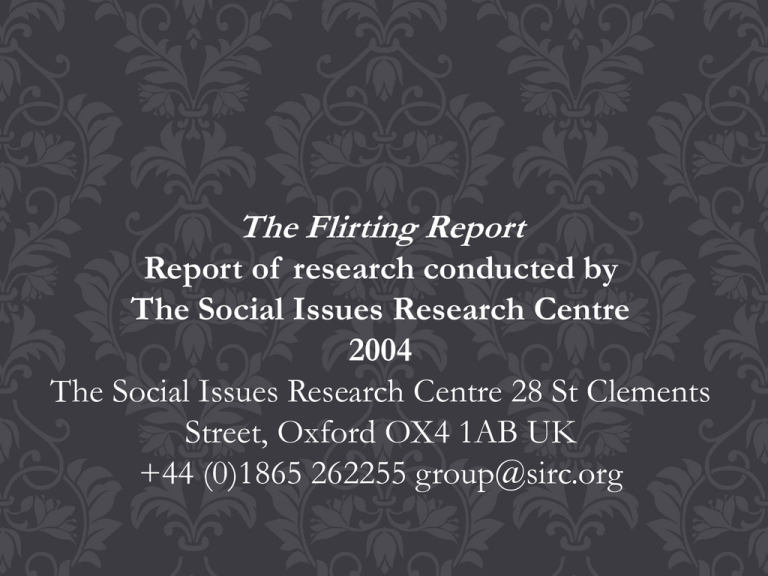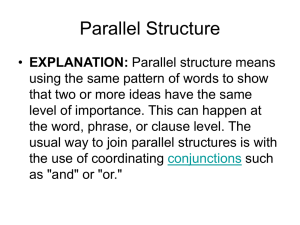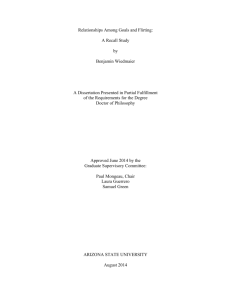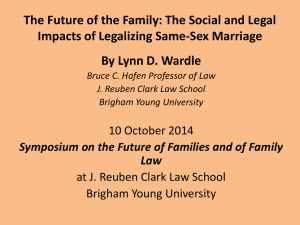The Flirting Report
advertisement

The Flirting Report Report of research conducted by The Social Issues Research Centre 2004 The Social Issues Research Centre 28 St Clements Street, Oxford OX4 1AB UK +44 (0)1865 262255 group@sirc.org FLITING HABITS • Are flirting habits being affected by modern trends and innovations, such as the advent of email and internet dating. • Which aspects of flirting are 'innate' and unchangeable,and which are influenced by new sociocultural trends and patterns? And of course, the Big Question: should women takethe initiative and ask men out? WHAT IS FLIRTING? To behave or act amorously without emotional commitment' or 'To make playfully romantic or sexual overtures'. TWO TYPES OF FLIRTING There is flirting for fun – the sense conveyed by the dictionary definitions – there is also what we might call 'flirting with intent', that is flirting as part of the mate-selection and courtship process: flirting to get someone into bed, or into a relationship. FLIRTING GESTURES Human flirtation involves sequences of gestures and expressions not unlike the 'courtship dances' of birds and other animals that we see on wildlife programs. Characteristic features of the human flirtation sequence include (intense eye contact), the smile, body synchrony, female coy looks and head-tossing, and male chest-thrusting. FLIRTING CONFUSION The initial stages of 'flirting with intent' can thus appear, to the naked eye, indistinguishable from 'flirting for fun' – and this similarity can be a source of confusion and misunderstanding, most problematically when a bit of flirtatious banter is mistaken for something more serious. We may be 'wired to flirt', but it seems that the wires can sometimes get crossed. "If flirting is instinctive, why do we get it wrong? Why are there so many misunderstandings?" SELF HELP (POP CULTURE) • The answer is that although we are programmed to flirt, flirting, like every other 'instinctive' human activity, involves an element of social learning. • These rules dictate where, when, with whom and in what manner we flirt. • We only become aware of the rules when someone commits a breach of this etiquette – by flirting with the wrong person, perhaps, or at an inappropriate time or place. • This potential for misunderstanding and confusion helps to explain the popularity of self-help books on flirting and dating manuals. OPTIMISTIC MALES Misunderstandings can arise, for example, from the fact that men tend to mistake women's friendliness for sexual interest. • In fact, research has shown that men are inclined to interpret almost any positive female behavior as a sign of sexual availability. Although male over-optimism is natural, and not a sign that men are stupid or deluded • there is also evidence to suggest that women are naturally more socially skilled than men, better at interpreting people's behavior and responding appropriately. (Some scientists have even claimed that women have a special 'diplomacy gene' which men lack.) FEMALE DECEPTIVENESS • women send highly ambiguous, deceptive signals, particularly in the first minute of an encounter with a male. Women, albeit unconsciously, send unpredictable, misleading signals to 'trick' men into revealing more of their real intentions than they would otherwise do. • women manipulate men into 'showing their hand' –expressing their interests and intentions verbally – allowing the female to evaluate the male's suitability as a potential mate. • It is perhaps not entirely surprising, given the levels of ambiguity and deception to which they are subjected, that males of the species tend to become confused. “this may result in men's overestimation of female sexual interest." MATE SELECTION PATTERNS Males Often tend to select young, attractive mates and females select partners with power, wealth and status. Men therefore naturally tend to seek women who are younger than them and place greater emphasis on physical beauty, while women are more likely to favor older males with higher status and earning potential. THE RISE OF THE 'SINGLETON' • There has been much talk in recent years about the decline of marriage and the rise of the 'singleton' in modern Western cultures. • We are constantly told that people nowadays are staying single for much longer, cohabiting rather than getting married, delaying having children until much later, and more likely to divorce. • These tenets of popular wisdom are repeated so often that they have acquired the status of facts, and are rarely questioned. The statistics on our marriage patterns tell a different story. THE RISE OF THE 'SINGLETON • The broad statistics on marriage patterns may also be masking differences between social groups, particularly class differences. • There is evidence to suggest that the more affluent middle classes may well be marrying later • Indeed most are fairly steadily upwards, with women in particular marrying later and later. THE RISE OF THE 'SINGLETON • In fact, marriage is as popular as it has ever been: over 90 percent of us get married. • Divorce rates in Western industrialized cultures have increased dramatically, since the Industrial Revolution. But current divorce rates in such cultures cannot be regarded as abnormally or unnaturally high: • High divorce rates are typical of all societies in which spouses have higher economic independence. • The 'rise of the singleton' is merely an illusion. We may be statistically just as likely to marry as ever before THE PETER PAN CULTURE • It is also clear that our perceptions have changed, and many people nowadays feel under less pressure to get married or 'settle down' with a long-term partner while still in their twenties or thirties. "I am quite happy being single. I don't have time for a boyfriend. Sometimes after a bad day I think I'm only 35. I don't feel ready for all that grown-up get-married-have-kids stuff ” • But it's a bit different for women, because of the biological clock. It seems that, for many people in our society, the 30s are the new 20s. THE PETER PAN CULTURE • We are living longer and healthier lives than ever before in human history, and we are able to look and feel youthful for much longer. It is no longer unusual for women to delay having children until their late thirties or even later (some forecasters are predicting that up to a fifth will remain childless in the not-toodistant future). • The kind of tastes in fashion and entertainment – as well as views on marriage, commitment and responsibility – that used to be characteristic of teenagers or people in their 20s are now being expressed by people in their 30s. • Adolescence is being stretched at both ends, with children reaching puberty earlier, and, apparently, reaching what might be called 'maturity' considerably later. THE BIG QUESTION • Should women take the initiative and ask men out? • It is already established that women do in fact initiate the majority of flirtatious encounters, but this is done with subtle use of body language. • Women may discreetly 'solicit' male attention, and convey their interest and attraction in a multitude of subtle signals, but the man is still usually expected to take the ultimate risk of asking for a date. THE BIG QUESTION • In fact, men love it when women take the initiative. Men perceive women who take the initiative in asking a man out as more sexually available. If the man, being asked out finds the woman in question reasonably attractive, the research evidence indicates that he is highly unlikely to turn her down. • So, the risk of rejection in asking a man out (providing one chooses a man who has shown at least some evidence of initial attraction) would seem to be extremely low. • But a woman contemplating this break with tradition must also weigh up a number of other factors THE BIG QUESTION • First there is the risk that the man will automatically regard her as more sexually available than women who do not take this initiative. • Second If a woman is looking for respect and for something more than a one- or two-night stand, it seems that asking a man out is not advisable. THE BIG QUESTION So, what is the answer to the Big Question? Should women ask men out or not? • Leaving aside our egalitarian, feminist sensibilities, balance, males still tend towards an over-optimistic interpretation of female signals, females still judiciously adjust their signals to encourage only selected males, while allowing males to think that they are making the choice. • Some females may occasionally attempt to take charge of the entire process, denying males the already very small element of control nature has left them, but the majority, perhaps wisely, stick to the tried-and-tested formula. FLIRTING ZONES Parties • Christmas parties and New Year celebrations – flirtatious behavior is not only socially approved, but almost compulsory, or at the very least expected. • 'Cultural remission' does not mean shedding all your inhibitions, letting rip and behaving exactly as you please. FLIRTING ZONES Drinking-places: pubs, bars and night-clubs • Obvious choices, you would think, but although public places where alcohol is served seems appropriate, but the lack of an obvious common interest means that one still has to struggle to think of something to talk about. FLIRTING ZONES Learning-places: schools, universities, colleges • Almost all educational establishments are hot-beds of flirting. The shared lifestyle and concerns of students, and the informal atmosphere, make it easy for them to initiate conversation with each other. Simply by being students, flirting partners automatically have a great deal in common, and do not need to struggle to find topics of mutual interest. FLIRTING ZONES Singles' events and dating agencies • Many people are embarrassed to admit to 'resorting' to dating agencies: they feel it is undignified, an admission of failure. The truth is, however, that there is nothing at all unnatural or undignified about organized matchmaking











